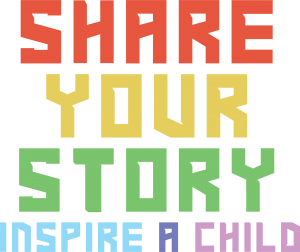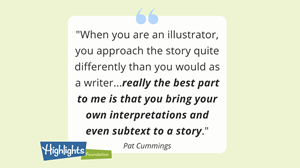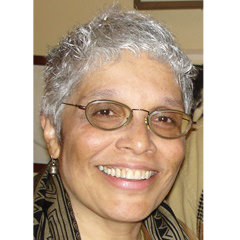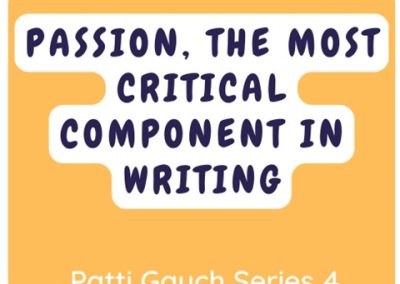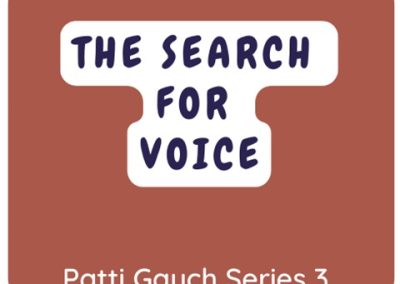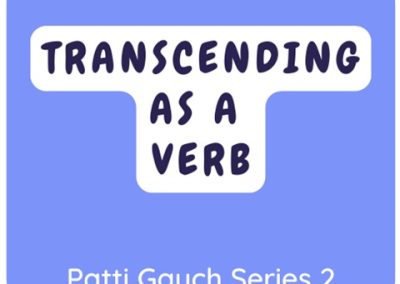Pat Cummings stopped by the blog today to answer a few questions about The Crash Course in Children’s Book Publishing: Illustrator’s Edition. She’s faculty for the course, along with editor Harold Underdown. Thanks, Pat!
What’s the main difference between the Crash Course: Illustrator’s Edition, and the traditional Highlights Foundation Crash Course in Children’s Publishing?
We’ll cover a lot of the same information because, whether you’re a writer or an illustrator, the same contracts with the same details apply. So there will be some overlap, although illustrators will have specific contractual considerations like ownership and sub-right sales of their imagery.
When you are an illustrator, you approach the story quite differently than you would as a writer. What I’ve seen is that a lot of people, when working on their first book anyway, often approach the work literally: they simply show what the words have already described. ‘Illustrate’ comes from a Latin root that means to enlighten. There is so much more that art can and should do in a picture book.
So, we’ll talk about the underlying concepts—how you approach a manuscript technically, visually and emotionally. Because this is a communications medium and you must keep in mind how very young the viewer is and what they’ll understand.
Also, (and really the best part to me) is that you bring your own interpretations and even subtext to a story. In picture books, art provides much of the narrative…so you can bring in extra story, extra characters, even another point of view. There are many ways to look at the manuscript and illustrators have to think about things like scale, layout, color, and line. How might they best convey the emotional impact of a scene? It’s quite different than just illustrating whatever the words say. So we’ll talk about visual elements to consider that can enhance the reader’s experience.
Basically, when you’re trying to get that first book, you just hope to get your work out of the publisher’s ‘slush pile’. One big advantage as an illustrator that writers don’t have is that you can send sample artwork to publishers in the form of promotional pieces. Every publisher accepts them, you don’t need an agent for that. And if publishers find your work interesting, they’re likely to be in touch.
We’ll cover how to make your work more appealing: how to show that you can capture an entire narrative with one image. Because, I guarantee that if publishers see you can tell a story with one illustration, they’re more likely to trust you to handle a whole book.
So, that’s the main difference: this course will focus on the underlying concepts and guidelines that go into illustrating for a young audience.
What skill level or experience do you need to benefit from the Crash Course: Illustrator’s Edition?
I believe you’ll benefit no matter what skill level you’re at currently. It’s good to know what might work for you right now as well as what skills you may need to acquire.
I’ve seen work of all different levels succeed, frankly. I’ve had people come to workshops who’ve done stick figures and they got a book contract. Because, whatever you style you do, if you do it well, publishers will notice.
And if you feel like you need to improve? Well, everybody needs to improve. Everybody needs to keep refining their skills. Most professional illustrators I know continually experiment, learn new skills and grow. One goal of this workshop is to help you define which skills you need to strengthen. Ideally, the aim is to bring all of your work up to the level of the best thing you do.
For example, if you’re a colorist, and a beautiful color sense sets your work apart, then you need to bring all your other skills up to that level. When I’ve been at portfolio shows and listened to editors, art directors, and agents, that’s what they’re looking for: a consistent skill level.
They may look at a portfolio that has ten pieces in it. Seven are fabulous, and three are not. And they conclude: “This person’s not ready because those three are not up to this level, and they don’t realize it.” They won’t take a chance on a book being 70% great. It’s a question of judgement, of being able to recognize what works and what doesn’t work in your illustration. And there are many ways to test it, many little tricks that can help you check your work. So, whatever level you’re at, this workshop can take you to the next level.
From Harold, you’ll also get practical information about how to get your work out there, what the publishing process involves and so on. We cover both craft and business.
Do you have any closing thoughts?
I just hope to see you at the workshop. First of all, I LOVE LOVE LOVE children’s books. And if you love illustrating, and this is something you want to pursue, this is a great opportunity to do it.
Because you’re going to be exposed to tons of information and several people who can really help you move your illustration forward. So much that goes into this work is emotional and personal, and very, very delightful. And, what’s best about workshops like this is that you’re surrounded by people who love doing what you love doing. That’s always instructive and energizing.
The arts are not an easy field to pursue, you know. It helps to have friends who are there for you, to find your community. And this is a really supportive workshop, so I hope to see you all there.

